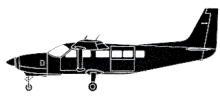Incident Overview

Description
A Cessna 208B Grand Caravan turboprop plane, ZS-OTU, operating on a flight for Air Nave, was destroyed when it struck terrain shortly after takeoff from Windhoek-Eros Airport (ERS), Namibia. The pilot and two passengers were killed in the accident; one passenger survived. The aircraft was carrying a cargo that included paint, building materials and foodstuff on a flight to Ngiva, Huambo and Luanda. The airplane failed to gain sufficient height after takeoff. It turned right, descended until it struck terrain and ploughed into some bushes. The day before the accident cargo weighing about 810 kg was loaded into the aircraft by a handling agent, under the pilot’s supervision. Before departure on the morning of November 15, though, additional cargo was loaded on board, along with the luggage of the passengers an pilot. These were not weighed. The additional cargo had been placed inside the cabin on top of and between seats, all the way to the roof of the plane without being secured. The aircrafts total weight at the time of take-off was 9691 pounds (4395 kg). The maximum certified take-off weight for this type of aircraft is 9062 pounds (4110 kg). The pilot had made one fundamental error in his weight calculation, by using an incorrect empty aircraft weight of 4575 pounds (2075 kg), instead of the correct weight of 5174 pounds (2347 kg). As a result, the aircrafts maximum take-off weight was exceeded by 629 pounds (285 kg). The aircraft failed to maintain flying speed and stalled shortly after take-off, rendering ground impact inevitable. Inadequate oversight by the regulatory authority should be regarded as a significant contributory factor to this accident.
Primary Cause
Incorrect aircraft weight calculation leading to exceeding maximum takeoff weight.Incorrect aircraft weight calculation leading to exceeding maximum takeoff weight.Share on:




